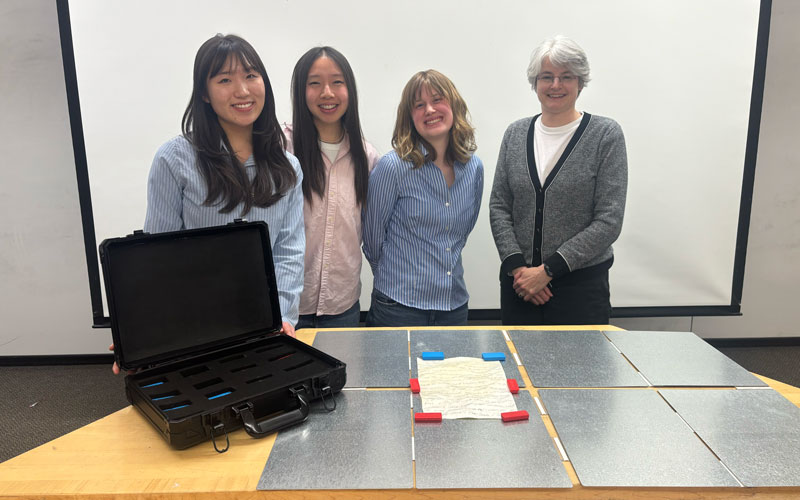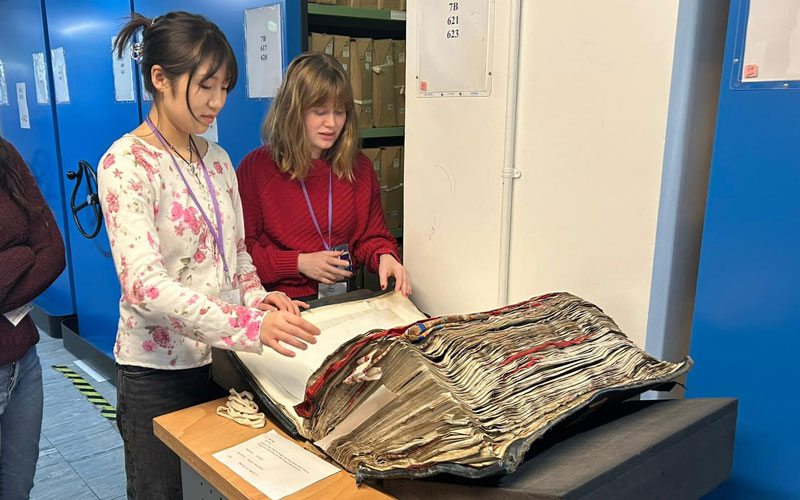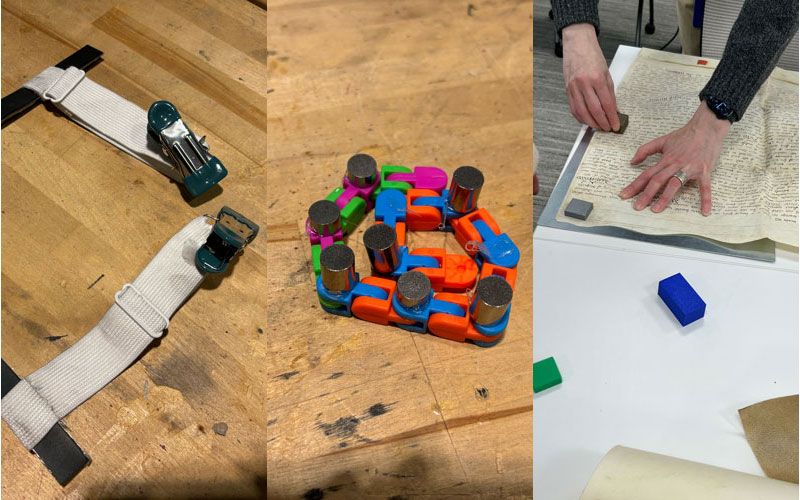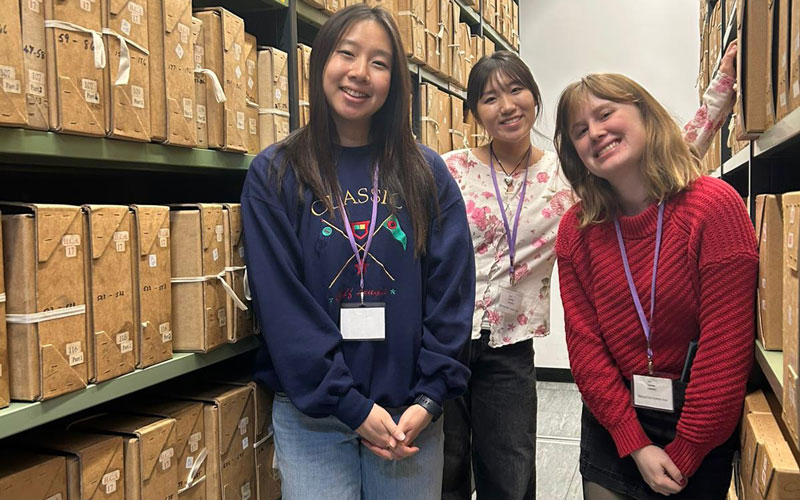Taming the Beast: Students Design a Magnetic Solution to Flatten Parchment for AI Research
Design students develop portable magnetic mat to aid historical manuscript research

When a student team in DSGN 384: Interdisciplinary Product Design first heard their project assignment — "manuscript flattener" — they imagined something simple.
"At first I thought, oh, we’re flattening paper,” Michelle Sheen (’26) said.
But then she touched the documents she was tasked with flattening.
Their “paper,” it turned out, was hundreds of years-old parchment: animal skin, often thick and stiff, curled into creases by centuries of storage and travel. Their client, Northwestern law professor Emily Kadens, had a modern problem: she needed a way to hold these unruly documents flat while photographing them for an AI tool she’s developing to transcribe their text. The existing archival solutions — weighted bean bags and gravity — weren’t cutting it.
“Parchment documents are literally like beasts,” Daisy Bai (’26) said. “They used to be animals, so you can still see hair follicles and skin patterns from the sheep and goat skin. And they resist any effort to flatten them.”
The team — Segal Design Certificate students Sheen, Bai, and Iliana Garner (’26) — took on the challenge as part of DSGN 384, a two-quarter course co-taught by professors Stacy Benjamin and John Anderson. With guidance from faculty, experts, and users, the team embarked on a meticulous design journey rooted in empathy, iteration, and hands-on exploration.
An unfolding problem
When the team first met with Kadens, the Williams Memorial Professor at the Northwestern Pritzker School of Law, the group learned that modern archival researchers rely on photography instead of on-site transcription. For Kadens’ research, that meant photographing large parchment documents stored in the National Archives in London — an essential step not just for efficiency, but for training an AI transcription model.
“The AI model doesn’t do magic,” Kadens said. “If it can’t see everything in a photo of parchment document because there’s tears or crumples or folds, it’s not going to be able to do anything better than I can do if I can’t see it.”
But these centuries-old documents are anything but cooperative.
“Parchment holds its shape,” Kadens said. “It’s kind of like if you imagine taking a piece of cardboard and folding it. Unfold it, and it’s not going to stay unfolded.” That resistance makes flattening parchment documents both a literal and logistical challenge.
A magnetic breakthrough
The student team didn’t grasp the full scope of the problem until a grant-funded trip to the Archives in London.

"We couldn’t have gotten that experience until actually visiting the place," Bai said. "We needed to feel the beast in our hands and experience the physical environment to really understand the problem."
The on-site visit to the National Archives reading rooms marked a turning point. During their trip, they saw and met with archivists and conservationists struggling with bean bag weights and unwieldy documents.
“There’s a wider use case for this,” Sheen said. “It’s a niche problem, but not a unique one.”
Using insights from Kadens and the archivists, the team cycled through multiple rounds of ideation, sketching concepts and building prototypes to test its theories.
“I didn’t realize how many physical iterations we would go through over the course of the project,” Garner said. “By the end of our project, we had a cabinet full of previous prototypes and rejected ideas.”

Finally, the team landed on its idea: magnets.
The final prototype, dubbed MagnaFlat, is a two-component system. The base is made of foldable carbon steel sheets, forming a mat that can accommodate large documents up to 28 by 40 inches and can collapse down to the size of a laptop. The second component is a set of small but powerful rare-earth magnets, encased in 3D-printed housings. These magnets are placed directly on top of the parchment to pin it flat against the metal base.
Designing for use in a high-security archive added an extra layer of complexity. Kadens noted that “you can’t just walk into the reading room with big metal sheets.” The students had to find materials that passed safety checks, didn’t pose risk to fragile documents, and could be easily transported. While their prototype needs more development to be used in the archives reading room, the path forward looks promising.
Lessons beyond the archive
As the quarters came to a close, the team members reflected on what they’d learned. For Sheen, it was a deepened appreciation of iteration.

"I can’t get too attached to one idea,” Sheen said. “You have to be open to new ideas and be ready to conduct testing and jump onto the next idea.”
Bai’s biggest takeaway was about collaboration.
“Transparent communication is absolutely essential when it comes to group work. Maintaining a very clear line of communication was the key to success,” Bai said.
For Garner, it was about being open to new information and ideas.
“I'm most proud of how many stakeholders we engaged with throughout the project,” Garner said, “and the fact that we stepped into a completely new environment to carry the project to completion.”
Kadens, too, found the collaboration memorable.
“It was really fun to see how curious, creative, thoughtful, and dedicated they were. And it’s always fun to see students experience the archives with such astonishment and wonder,” Kadens said. “They were really, really into it.”
As for the “beast” itself? Thanks to a thoughtful design and a few strategically placed magnets, it just might be tamed.
